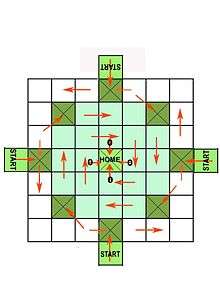Ashta Chamma (board game)
ashta Chamma game in telugu language


Chowka Bara (Kannada: Chowka bara) or Ashta Chamma (Telugu: అష్టా చమ్మా)) is an Indian board game, played during the era of kings. This game was used to improve eye-to-eye coordination, and to teach teenagers war tactics and strategy. It also helps in developing counting skills.
The movement of coins is controlled by throw of 4 or 6 cowry shells. Ashta Chamma is primarily a game of chance, but involves thinking and planning. It is an interesting and amusing way to develop strategy skills. Instead of cowries, dice can also be used.
This game is divided for Juniors and Seniors. The Junior board consists of 5x5 grid with 5 crossed boxes and the Senior board consist of 7x7 grid with 8 crossed boxes.
Names
This game is called by various names in different languages in different regions of India. This list shows the name, the language and then the region:
- Chauka Bara - Kannada - Mysuru region
- Katte Mane - Kannada - Rural Mysuru
- Gatta Mane - Kannada - Rural Mysuru
- Chakaara or Chakka - Kannada - North Karnataka
- Pakidakali - Malayalam - Kerala region
- Ashta Chamma - Telugu - Andhra Pradesh/Telanganaa
- Daayam or Thaayam - Tamil - Tamil Nadu
- Kaana Duaa - Hindi - Madhya Pradesh
- Kavidi Kali - Malayalam - Kerala
- Chung - Hindi - Madhya Pradesh
How the game is played

The game is controlled by throwing four cowry shells and counting how many are 'as it is' verses those that land 'inverted'. if all four shells land inverted it is called "chamma" and if all land as it is then it is called an "ashta".
The tokens enter the board only after a Chamma or Ashta is thrown. Since each cowrie carry 2 points, 2 tokens for Chamma and 4 tokens for Ashta are entered on the board. The tokens travel anti-clockwise in outer squares, clockwise in inner squares and finally lands up in central square (home), with a throw of Ashta or Chamma. If a player’s token lands on a square occupied by opponent’s token, then the opponent’s token is "killed" and the player gets an extra turn to play. The killed token returns to its starting home square and has to go round all over again. In crossed boxes, killing is not possible. When a token reaches the square left of its home square, it further moves up into the inner squares and now moves in clockwise direction. However the tokens enter the inner squares, only when at least one of the opponent's tokens are killed. Otherwise they keep circling around until at least one of the tokens of opponent is killed by them. Every token need not kill an opponent. Each token finishes its race when it manages to get into the home. The first player to get all his tokens into home wins the game.
Whenever a Chamma or an Ashta (4 or 8) is obtained during a throw of cowry shells, the player gets a bonus turn to throw the cowries. When a player cuts an opponent’s token, he gets an extra turn to play. During an extra turn, either the same token or some other token can be played. If a player throws either a Chamma or an Ashta three times consecutively during his turn, he is out, and cannot use any of the moves. If a player has cut once, all the coins can move into the inner circle, not necessary for every coin to cut opponent. When most of the tokens are dead, it is possible to bring back the dead tokens. For Ashta, 2 tokens and for Chamma 1 token can be brought back.
Cowries and their values:
- 3 as it is, 1 inverted - Move 1 square
- 2 as it is, 2 inverted - Move 2 squares
- 3 inverted, 1 as it is - Move 3 squares
- 4 inverted Chamma - Move 4 squares
- 4 as it is Ashta - Move 8 squares
In Senior board (8x4=32) tokens of four distinct colors are used. Since each cowry carries 1 point, 4 tokens for Chamma and 8 tokens for Ashta are entered on the board. The rules of playing Senior board is same as that of Junior board. When most of the tokens are dead, it is possible to bring back the dead tokens. For 8, 1 token, for Ashta, 4 tokens and for Chamma 2 tokens can be brought back
Cases when cowries are cast:
- 1 inverted and 7 as it is; move 1 square
- 2 inverted and 6 as it is; move 2 squares
- 3 inverted and 5 as it is; move 3 squares
- 4 inverted and 4 as it is; move 4 squares
- 5 inverted and 3 as it is; move 5 squares
- 6 inverted and 2 as it is; move 6 squares
- 7 inverted and 1 as it is; move 7 squares
- 8 inverted Chamma; move 4 squares
- 8 as it is Ashta; move 8 squares
- 8 inverted drakshi move 16 squares
In popular culture
Ashta Chamma plays a pivotal role in the 2006 Indian art house film Vanaja.
In 2008, a Tollywood comedy film, Ashta Chamma, was released, which was written and directed by Mohan Krishna Indraganti. The film deals with four quirky friends interwoven in a romantic narration.
References
- Online KavidiKali (Malayalam name of Ashta Chemma)
- Peddabala Siksha (Telugu Encyclopedia) - by Gajula Satyanarayana